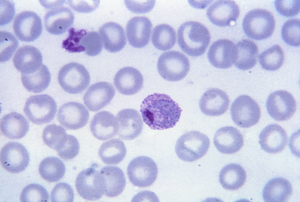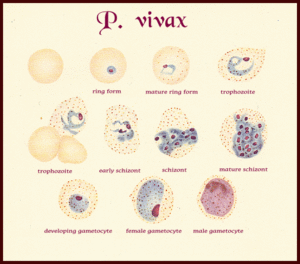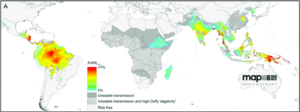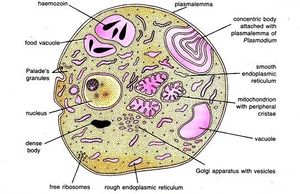Plasmodium vivax
Classification
Domain: Eukaryote
Phylum: Apicomplexa
Class: Aconoidasida
Order: Haemosporida
Family: Plasmodiidae
Genus: Plasmodium
Species
|
NCBI: Taxonomy |
Plasmodium vivax
Description and Significance
Appearance
P. vivax are parasites found inhabiting the liver and blood at various stages of development and shape. Starting as rings within red blood cells, then trophozoites as they develop within the red blood cells. Next, they form round gametocytes filling the red blood cells and schizonts which are elongated and wormlike, further filling out the red blood cells. Red blood cells infected by P. vivax cause swelling of the cell, increasing the size by approximately 1.5 times the normal size of red blood cells.
Habitat
P. vivax is found within South America and Asia, along with smaller amounts found within the horn of Africa and Madagascar. P. vivax is the most widespread of human malaria, with farther reaches than the temperate limited Plasmodium falciparum more commonly considered for malaria infections, enabled by the parasite forming a dormant stage within the human liver, enabling safe storage for the parasite during mosquito-free cold seasons.[b]
Signifigacne
P. vivax has great significance due to the formation of hypnozoites within the liver of infected human hosts. This hypnozoite stage leads to a "hibernation" where P. vivax remains dormant until unknown (but linked to mosquito vector bites[b]) factors trigger growth. This activation leads to relapses of symptoms weeks, months, or years later remaining infectious throughout [c]. This continual infectious period makes treatment, eradication, and control of the parasite difficult.[c]
Genome Structure
P. vivax has a genome characterized by 12-14 linear chromosomes found within a nucleus with a range of 1.2 Mb to 3.5 Mb, with an estimated genome of 35 - 40 Mb. Protein-coding genes have been attributed to GC-rich isochores and chromosome ends with AT-rich isochores at the telomeres. Approximately 5000 genes have been predicted.[d]
Cell Structure, Metabolism and Life Cycle
Life Cycle / Cell Structure
Plasmodium genus eukaryotes form a typical lifecycle characterized by infection from insect host to the vertebrate host. P. vivax first enters a vertebrate host through injection by Anopheles mosquitoes (female only) where P. vivax make their way from the blood to the liver where they, entering hepatic cells and undergoing replication before exiting to infect erythrocytes and forming hypnozoites and merozoites, some differing to form gametocytes to be picked up by other mosquitoes to continue the cycle.
Human Infection
P. vivax starts the infection cycle through an infected mosquito sending saliva into an injection wound while extracting blood to stop coagulation of the blood, sending sporozoites from the mosquito's salivary glands into the bloodstream. From the bloodstream, the sporozoites reach the liver through gliding motility. Once the sporozoites reach the liver they enter the hepatic cells within and begin to reproduce asexually forming trophozoites and merozoites within.[d]
Liver Stage
The sporozoites enter the hepatocytes and start multiple rounds of division without segmentation, creating a large parasitic mass until segmenting into merozoites that rupture out into the bloodstream due to swelling. Some remain dormant in a hypnozoite stage for weeks to months until being triggered for growth into the segmented merozoites.
Erythrocytic Stage
P. vivax penetrates young red blood cells (reticulocytes) differing from the more commonly studied P. falciparum which invades mature red blood cells (erythrocytes). Once released P. vivax uses 2 proteins to enter the red blood cell(PvRBPP-1 and PvRBP-2), recognizing the Duffy blood group antigens (Fy6) to penetrate the red blood cells. Once inside, to synthesize its proteins, P. vivax obtains its amino acids through a variety of means using de novo synthesis (where complex molecules are formed from simple molecules), import from host plasma, and digestion of host hemoglobin.P. vivax then replicates asexually until the red blood cell ruptures, releasing the multiplied parasites to the bloodstream. This swelling forms red blood cells larger in size, identifiable through dotting on their surface call Schüffner's dots as seen within the trophozoite stage figure.
Mosquito Infection
Once a female Anopheles mosquito bites an infecter host, the blood taken up during feed can contain gametocytes (along with other stages of P. vivax) that make their way to the mosquito's stomach. Once there, the gametocytes form into gametes through gametogenesis. Microgametocytes develop daughter nuclei that arrange themselves on the edges of the microgametocyte where cytoplasm develops into thin projections where nuclei enter then break off into male gametes (microgametes). Macrogametocytes develop a cone of reception on one side developing into female gametes (macrogametes)[e].
Fertilization
Male gametes search throughout the stomach for female gametes. Once male gametes find female gametes, they enter through the cone of reception, fusing and forming a zygote through 'anisogamy'. The zygote then becomes vermiform (wormlike) and motile, termed an ookinete. The ookinete penetrates the stomach wall of the mosquito and develops a cyst layer while embedded within, absorbing nutrients, growing in size, and changing into a full oocyst.
Sporogony
The oocyst continues to divide and create daughter nuclei, developing vacuoles within the cytoplasm within along with cytoplasmic masses. These masses elongate and house the divided daughter nuclei, before the oocyst bursts releasing the sporozoites into the hemolymph of the mosquito. The sporozoites migrate to the salivary glands where they remain till being injected into their new vertebrate host, repeating the cycle.
Ecology and Pathogenesis
Symbiosis
P. vivax along with other parasites within the Plasmodium genus rely on both an insect and vertebrate host to act as vectors for their infection. Additionally, P. vivax uses the proteins within the blood of humans to reproduce asexually and produce their own proteins while developing. Once within the blood new mosquitoes that have not been infected and can feed on the vertebrate host and themselves become an insect host to P vivax and further spread the infection to other vertebrae. This leads to the easy passive dispersal of the parasite. This parasitic nature leaves the hosts in potentially life-threatening danger, for up to years at a time while the symptoms of malaria cause damage.
Symptoms
exposure to P. vivax leads to a wide variety of symptoms, many potentially life-threatening through the breakdown and rupture of red blood cells within the bloodstream in combination with recurrent relapses of symptoms due to the periodic growth of hypnozoite stage parasites within the liver. Some symptoms include fever due to infection, infected blood cells attaching to each other, and leading to blockages within the circulatory system and deprivation of oxygen to cell tissue, along with infections leading to enlargement of the spleen. even showing early manifestation with hiccups, loss of taste, or urinary discomfort[f].
References
[a] Vogel G. The forgotten malaria. Science. 2013;342(6159):684‐687. doi:10.1126/science.342.6159.684
[c] Am J Trop Med Hyg. 2016 Dec 28; 95(6 Suppl): 15–34. doi: 10.4269/ajtmh.16-0141
[d] Carlton, J. The Plasmodium vivax genome sequencing project Trends Parasitol., 19 (2003), pp. 227-231
[e] https://www.cdc.gov/malaria/about/biology/index.html
Author
Page authored by Jonathan Ward, student of Prof. Jay Lennon at IndianaUniversity.





